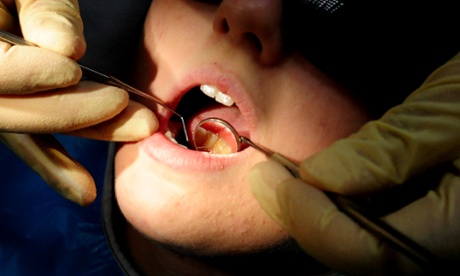Coag Reform Council paper highlights effect of cost on health choices as Coalition seeks to push through $7 GP co-payment

One in five Australians has delayed or avoided seeing a dental professional because of cost, according to a new report that also highlights concerns about the increased adult obesity rate and the likelihood of people with diabetes not managing their condition.
The report by the Council of Australian Governments (Coag) Reform Council shows people were particularly price sensitive in the case of visiting a dental professional but less so in the case of visits to a general practitioner (one in 17).
One in 12 Australians has delayed or avoided filling a medical prescription because of cost, a decision that is twice as likely in the most disadvantaged areas compared with the most advantaged areas.
The figures illustrate the impact of price on people’s healthcare choices as the Abbott government seeks to introduce a new $7 co-payment to visit a GP and increase the existing co-payment for medicines next year.
The Coag Reform Council – which is to be disbanded at the end of this month – painted a mixed picture of health progress over the past five years, with life expectancy lengthening (to 79.9 years for men and 84.3 years for women) but the proportion of those who are obese or overweight is increasing (to 62.7%).
The Coag Reform Council chairman and former Victorian premier, John Brumby, said the report found one in 25 Australians have type 2 diabetes, which was associated with obesity.
Brumby said it was particularly worrying that a quarter of people with type 2 diabetes did not know they had it, while half of people who knew they had it were not managing their condition properly.
“Clearly it shows a lot of people with type 2 diabetes don’t know they have it and that’s really dangerous,” Brumby told Guardian Australia.
“On the other side the driver, obesity and overweight, this is pushing through like a runaway train and, left unchecked, will produce inevitably an epidemic of diabetes and all of the consequences and costs associated with that.”
The national smoking rate has fallen from 19.1% in 2007-08 to 16.3% in 2011-12 but is still well above the Coag target of 10% by 2018. Rates of new lung cancer among women have risen 88% between 1982 and 2012 while rates for men have fallen 34% over the same period, reflecting a peak in female smoking rates in the 1970s and 1980s.
In a positive sign for the nation’s health, the rate of heart attacks fell 20.1% between 2007 and 2011 and the annual rate of deaths for circulatory diseases was down 15%.
But the report highlighted worrying aged-care figures showing the proportion of older people who took at least nine months to enter high residential care rose from 3.3% in 2008-09 to 14.1% in 2012-13.
The Australian Medical Association argued the good news in the report about improved health outcomes was overshadowed by the risks of the government’s “poorly designed” co-payment model.
The group’s president, Brian Owler, reaffirmed concerns that disadvantaged groups would be deterred from accessing preventative health care, and called on the government to scrap the co-payment model and seek expert advice.
Drawing on Australian Bureau of Statistics figures, the report showed 8.5% of people given a prescription by their GP delayed it or did not fill it due to cost in 2012-13. The 12.4% rate in the most disadvantaged areas was double the 6% rate in the least disadvantaged areas.
The report said people were more likely to delay or avoid seeing a dental professional due to cost than was the case for any other health professional.
In 2012-13, 18.8% Australians aged 15 years and over who needed to see a dental professional delayed or did not see one, the report said, more than three times the rate for GPs (5.8%). The dental deterrent was as high as 25.1% in the most disadvantaged areas compared with 12.0% in the least disadvantaged areas. Indigenous Australians were particularly price sensitive.
“Going to the dentist is expensive and the fact is many people simply can’t afford it,” Brumby said. “People make judgments about whether they can afford it.”
Brumby said it was not for him to comment on the implications of the report for the government’s proposed budget measures, but people could “draw their own conclusions”.
The treasurer, Joe Hockey, downplayed the potential impact of the planned new GP co-payment on discouraging the poor from accessing healthcare.
Asked about the figures on Thursday, Hockey said the doctor would have the capacity to determine who was unable to pay.
“What that proves is exactly what I’ve been saying, that healthcare is not free,” Hockey told the ABC.
“It’s not free at the moment and taxpayers pay in one form or another. If people are saying they’re unable to go to the doctor because they have to pay that illustrates that the healthcare is not free. What we’ve got to do is make sure we do not end up with a two-tier health system where the best professionals drift to the privately remunerated system and the public system, the one that is accessible for people at the moment without paying any upfront cost, is not weakened.”
The report also raised concerns that potentially preventable hospitalisation rates for vaccine-preventable and acute conditions had jumped 16% and 11% respectively between 2007–08 and 2011–12.
The Coag Reform Council was also concerned that median elective surgery waiting times increased for 14 out of 15 selected surgical procedures between 2007–08 and 2012–13.
